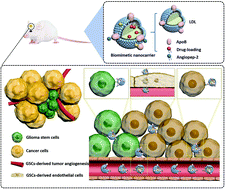Dual-triggered biomimetic vehicles enable treatment of glioblastoma through a cancer stem cell therapeutic strategy
Abstract
Glioma stem cells (GSCs) and their complex microenvironment play a crucial role in the high invasion of cancer and therapeutic resistance and are considered to be the most likely cause of cancer relapse. We constructed a biomimetic vehicle (LDL-SAL-Ang) based on a low density lipoprotein triggered by Angiopep-2 peptide and ApoB protein, to improve the transport of an anti-GSC therapeutic agent into the brain. The LDL-SAL-Ang showed significant inhabitation for GSC microsphere formation and induced the highest apoptotic rate in two types of GSCs. LDL-SAL-Ang reduced the number of GSC-derived endothelial tubules at a lower drug concentration and inhibited endothelial cell migration and angiogenesis. The pharmacokinetic analysis showed that the brain tissue uptake rate (% ID g−1) for LDL-SAL-Ang was significantly enhanced at 0.45. For anti-glioblastoma activity in vivo, the median survival time of LDL-SAL-Ang plus temozolomide group was 47 days, which were significantly increased compared with the control or temozolomide only groups. The endogenous biomimetic nanomedicine that we designed provides a potential approach to improve treatments for intracranial tumors and reduced neurotoxicity of nanomedicine.

- This article is part of the themed collection: 2021 Nanoscale HOT Article Collection


 Please wait while we load your content...
Please wait while we load your content...